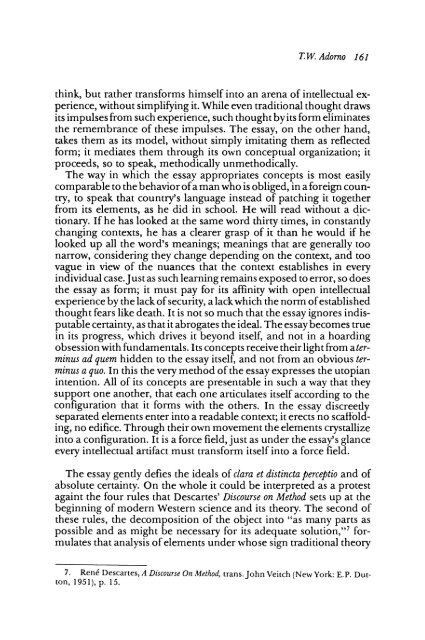Adorno-The-Essay-As-Form
Adorno-The-Essay-As-Form
Adorno-The-Essay-As-Form
Create successful ePaper yourself
Turn your PDF publications into a flip-book with our unique Google optimized e-Paper software.
T W.Adomo 161think, but rather transforms himself into an arena of intellectual experience,without simplifying it. While even traditional thought drawsits impulses from such experience, such thought by its form eliminatesthe remembrance of these impulses. <strong>The</strong> essay, on the other hand,takes them as its model, without simply imitating them as reflectedform; it mediates them through its own conceptual organization; itproceeds, so to speak, methodically unmethodically.<strong>The</strong> way in which the essay appropriates concepts is most easilycomparable to the behavior of a man who is obliged, in a foreign country,to speak that country's language instead of patching it togetherfrom its elements, as he did in school. He will read without a dictionary.If he has looked at the same word thirty times, in constantlychanging contexts, he has a clearer grasp of it than he would if helooked up all the word's meanings; meanings that are generally toonarrow, considering they change depending on the context, and toovague in view of the nuances that the context establishes in everyindividual case. Just as such learning remains exposed to error, so doesthe essay as form; it must pay for its affinity with open intellectualexperience by the lack of security, a lack which the norm of establishedthought fears like death. It is not so much that the essay ignores indisputablecertainty, as that it abrogates the ideal. <strong>The</strong> essay becomes truein its progress, which drives it beyond itself, and not in a hoardingobsession with fundamentals. Its concepts receive their light from aterminusad quem hidden to the essay itself, and not from an obvious terminusa quo. In this the very method of the essay expresses the utopianintention. All of its concepts are presentable in such a way that theysupport one another, that each one articulates itself according to theconfiguration that it forms with the others. In the essay discreet1separated elements enter into a readable context; it erects no scaftbl ‘?-ing, no edifice. Through their own movement the elements crystallizeinto a configuration. It is a force field, just as under the essay's glanceevery intellectual artifact must transform itself into a force field.<strong>The</strong> essay gently defies the ideals of clara et distinctaperceptio and ofabsolute certainty. On the whole it could be interpreted as a protestagaint the four rules that Descartes' Discourse on Method sets up at thebeginning of modern Western science and its theory. <strong>The</strong> second ofthese rules, the decomposition of the object into "as many parts aspossible and as might be necessary for its adequate ~olution,"~ formulatesthat analysis of elements under whose sign traditional theory7. Ren6 Descartes, A Discourse On Method, trans. John Veitch (New York: E.P. Dutton,1951), p. 15.


